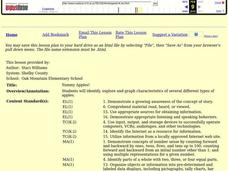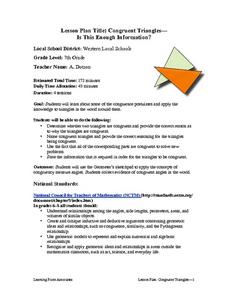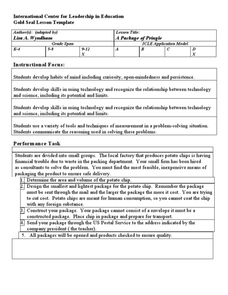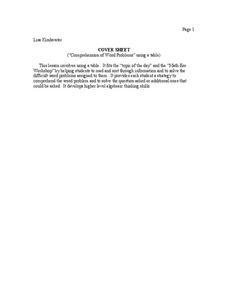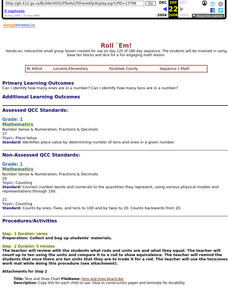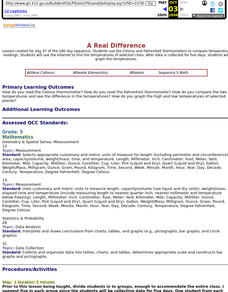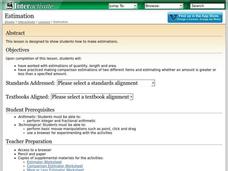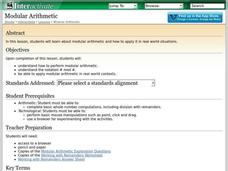Curated OER
Lego Robotics: Measuring Speed
Learners build and program a LEGO robotic car as well as measure and graph its speed. They acquire familiarity with principles of construction, motion, design and problem solving. They compare a robot's speed over two different surfaces...
Curated OER
Yummy Apples!
Students discuss apples and how they are grown. They listen as the teacher reads "Apples," by Gail Gibbons. Students discuss the story. They view several different types of apples and compare their characteristics. Students taste several...
Curated OER
What's the Difference?
In this finding the difference in sums instructional activity, 1st graders look over two boxes of numbers and circle the pairs of numbers in each box that have a difference of 9 in the first one and 6 in the second one.
Curated OER
Colorful Fractions
Students use charts to show fractions. In this fractions and percents instructional activity, students review fractions, percents and ratios. Students create tables and color the cells to make different fractions. ...
Curated OER
Congruent Trianges - Is This Enough Information?
Seventh graders determine whether two triangles are congruent and provide an explanation to why they are not. They apply concepts of measurement of angles and collect evidence of congruent angles in the world.
Curated OER
A Package of Pringle
Here is a problem-solving instructional activity that has learners take the role of a packaging expert to design an inexpensive means of packaging a potato chip. It could benefit from having more specific detail about the instructional...
Curated OER
Percents
Sixth graders, while in the computer lab, participate in the game Mission Magnetite where they utilize percents and fractions to stop Hacker from dropping magnetite on Motherboard Central. They follow the instructions precisely as they...
Curated OER
Managing My Money
Second graders use The Berenstain Bears' to learn about money management. In this money management lesson, 2nd graders read The Berenstain Bears' Dollars and Sense book and complete the 'Rainy Day' worksheet. Students then discuss the...
Curated OER
Using Nets to Find Surface Area
Eighth graders explore three-dimensional objects (prisms, pyramids, cylinders and cones) to draw nets. They use the understanding of drawing nets to find the surface area of pyramids and cylinders.
Curated OER
Exploring Arrangements of 2, 3, 4, and 5 Cubes
Students use problem solving skills to create various models of tricubes, tetracubes, and pentacubes. They classify the cubes into various groupings and identify them as mirror images, regular arrangements, and irregular arrangements....
Curated OER
"Comprehension of Word Problems" Using a Table
Sixth graders practice solving math problems by utilizing a data table. In this number sense lesson, 6th graders create a table using the numerical information about a fictitious farm's inventory. Students complete the empty segments by...
Curated OER
Symmetrical Journals
Students identify symmetrical shapes around their classroom and make symmetry journals. In this symmetry lesson plan, students make drawings of symmetrical shapes inside their journals.
Curated OER
Fraction Models
Third graders make models of fractions and mixed numbers. Using fraction strips and drawing pictures, 3rd graders develop conceptual understanding of the equivalent forms. Students use the number line to represent and compare...
Curated OER
Miles Mania- Rounding to the Nearest Hundred Worksheet
In this mileage and rounding worksheet, 3rd graders read distances between cities as shown on a map at the top of the page. They fill in a table using the names of the cities as determined by the rounded mileage between them. They answer...
Curated OER
Roll `Em!
First graders engage in using base ten blocks and dice for a fun engaging math lesson. They use a worksheet imbedded in this lesson as the game board to help them play this math game.
Curated OER
A Real Difference
Fifth graders use the Celsius and Fahrenheit thermometers to compare temperature readings. They use the Internet to find the temperatures of selected cities. After data is collected for five days, 5th graders graph the temperatures.
Curated OER
Miras, Mirrors, and Kaleidoscopes!
Students use hands-on activities to explore transformations. They view a video segment that demonstrate how M. C. Escher employed geometry and transformations to create so many of his famous drawings.
Curated OER
Estimation
Students explore the concept of estimation. In this estimation lesson, students discuss making estimates through teacher led discussion. Students use the Internet to complete an activity where they must estimate the length of lines.
Curated OER
The Quadratic Formula
Students solve quadratic function by completing the square. In this algebra lesson, students use the quadratic formula to factor quadratics and find the roots. They graph the parabola and identify its properties.
Curated OER
Modular Arithmetic
Students investigate modular arithmetic and how to use it to solve real world problems. In this modular arithmetic lesson, students use computers to work on modular arithmetic after a teacher guided lesson. They complete guided practice...
Curated OER
Calendar Counting
Students demonstrate how to count by 2's. In this number sense lesson, students review skip counting on the hundreds chart and recognize the pattern of counting by 2's. Students use a reproducible of a calendar to color in the days as...
Curated OER
Fractions and Fact Families: Jump Kangaroo Jump!
Second graders practice with fractions and fact families. In this fractions and fact families lesson, 2nd graders participate in a series of activities to assist them with understanding fractions. Activities include graphing,...
Curated OER
Rounding Numbers
Fourth graders complete math problems where they round numbers to the nearest ten, hundred, or thousand. In this rounding lesson plan, 4th graders explain how to round the problems they solve.
Curated OER
Reasonable Answers
In this reasonable answer worksheet, students estimate and circle the answer that make sense for a set of 6 word problems. Students choose from 2 possible answers.

